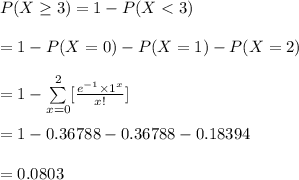
Mathematics, 12.10.2020 01:01 xXCoryxKenshinXx
Astronomers treat the number of stars X in a given volume of space as Poisson random variable. The density of stars in the Milky Way Galaxy in the vicinity of our solar system is one star per 16 cubic light-years, on average. NOTE: Light-years is a distance measure. 7. What is the probability of exactly two stars in 16 cubic light-years? 8. What is the probability of three or more stars in 16 cubic light-years? 9. How many stars would be expected in 4 cubic light years? 10. How many stars would be expected in t cubic light years? 11. How many cubic light-years of space must be studied so that the probability of one or more stars exceeds 0.95? HINT: let `t' represent the unknown region of space, then nd the `t' that gives you the relevant probability.

Answers: 2


Another question on Mathematics

Mathematics, 21.06.2019 23:00
The distance between two points is 6.5cm and scale of map is 1: 1000 what's the distance between the two points
Answers: 1

Mathematics, 22.06.2019 00:00
Find the distance between the point (-3,-4), and (see the picture below)
Answers: 1

Mathematics, 22.06.2019 00:00
The letters g e o r g i a are placed in a bag . if you picked a card and knew it was a vowel , what is the probability that it is an a ?
Answers: 1

Mathematics, 22.06.2019 01:10
Do xuan nam isgoing to invest $1000 at a simple interest rate of 4% how long will it take for the investment to be worth $1040?
Answers: 1
You know the right answer?
Astronomers treat the number of stars X in a given volume of space as Poisson random variable. The d...
Questions


Mathematics, 29.01.2021 23:00

Mathematics, 29.01.2021 23:00

Mathematics, 29.01.2021 23:00


English, 29.01.2021 23:00


Mathematics, 29.01.2021 23:00

Mathematics, 29.01.2021 23:00

Spanish, 29.01.2021 23:00

Mathematics, 29.01.2021 23:00




Chemistry, 29.01.2021 23:00

English, 29.01.2021 23:00

Mathematics, 29.01.2021 23:00


English, 29.01.2021 23:00







